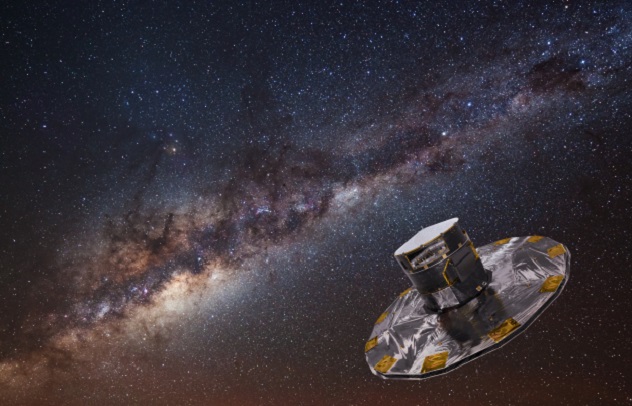Space as a context for teaching science: the Gaia spacecraft mission

Twenty-three UK secondary school teachers attended a continuing professional development (CPD) activity which introduced the Gaia mission as a context for teaching space science in the classroom. The event took place at the Rutherford Appleton Laboratories (RAL Space) and was run by Tania Johnston, Senior Public Engagement Officer, STFC. Experts on the Gaia mission were on hand to explain Gaia science and educational specialists translated the concepts into practical activities for teachers to use in the classroom. The educational activities linked the key components of Gaia to the school/college syllabus.
Tania Johnston began by running a telescope sorting exercise to break the ice, where the teachers were encouraged to think about the different wavelength regions at which telescopes operate, the size of the mirror and the height above sea level. Professor Gerry Gilmore, Principal Investigator for the UK involvement in Gaia, gave a fascinating introduction to the Gaia mission. Gerry introduced some of the history behind the science goals of Gaia and the complexities of the measurements. He explained how Gaia will measure one billion stars in our galaxy, most of these in 12 dimensions! But that this actually isn't even as many dimensions as we think in all the time! As dimensions in this case are really attributes or features and include position, distance, size, colour, motion, rotation, shape ,texture, brightness, changes (others we use every day include sound, taste, and smell).
 Dr Peter Allan, Deputy Director of RAL Space, kicked off the Monday morning introducing RAL Space and some of the space missions in which they are involved.
Dr Peter Allan, Deputy Director of RAL Space, kicked off the Monday morning introducing RAL Space and some of the space missions in which they are involved.
Dr Anna Hourihane gave a very interesting more in-depth overview of the Gaia mission, discussing some of the great science which Gaia will revolutionise, including the structure of our Milky Way Galaxy and how it actually came to form. Then I introduced the Gaia Alerts (detection of the changes of brightness of sources) and how students in schools can contribute to real science discoveries by operating a robotic telescope (e.g. the Faulkes telescope), taking images of sources detected as having changed in brightness by Gaia, to investigate what the sources really are - e.g. explosions of stars called supernovae.
Dr Floor Van Leeuwen gave a really clear and informative talk on the astrometry of the Gaia mission and how difficult it is to measure the distances in our Galaxy, to the precision that we need using parallax. Gaia's precision is the same as measuring the thickness of a human hair in Paris from London! Then Sophie Allan from the National Space Centre, Leicester ran an activity where the teachers measured parallax angles of faraway objects using giant protractors – an activity that can be used in the classroom to help students understand how Gaia measures the distances to stars - the same reason we have two eyes!
In the afternoon I introduced the teachers to the photometry of Gaia (how it measures the brightness and colour of a star over time) and its billion pixel camera which is used to create this very precise photometry of one billion objects. And Sophie Allan got the teachers to try out some online photometry resources from the Faulkes telescope. An expert form RAL gave the teachers an introduction to ground stations which receive the data from satellites. They have one at RAL and showed us one of the dishes moving!
Dr George Seabroke from the Mullard Space Science Laboratory part of University College London explained to the teachers how Gaia will measure radial velocities using the radial velocity spectrometer. Gregor Steele from Scottish Schools Education Research Centre got the teachers running around making doppler-shifted spectra with an iphone app. In the final session of the day, Ed Polehampton and Chris Pearson got the teachers to take part in an activity which they can take back to the classroom, for building a rocket, which has to have space for the satellite inside. Then in the evening Professor Mark McCaughrean gave a really engaging public talk about the incredible array of ESA satellites. Including obviously Gaia and Rosetta the satellite. Mark mentioned a cool animation about Rosetta.
The second day started with a demonstration by Tom Lyons from the National STEM Learning Centre in York, of how to launch your mobile phone on a rocket made of an empty lemonade bottle, water and a foot pump! The idea of attaching your phone is that you can record the launch using an app to measure the take off. Then we had some really interesting tours around the Mars yard and the Vibration testing facilities at RAL.
After lunch the teachers had a go at making a structure out of only spaghetti, and marshmallows that needed to hold an egg and withstand vibration testing! Some very interesting ideas were tested and most worked really well, however one group's structure collapsed even before it was vibration-tested! The teachers also had a go at a thermal-testing experiment to test the properties of different materials.
The day ended with a plenary session by Professor Gerry Gilmore, who discussed some of the questions which had come up over the few days of the course. Then the teachers went on a tour around the ISIS experiment at RAL.
We have an exciting opportunity for teachers to participate in this year's explorative CPD activity happening this June.
